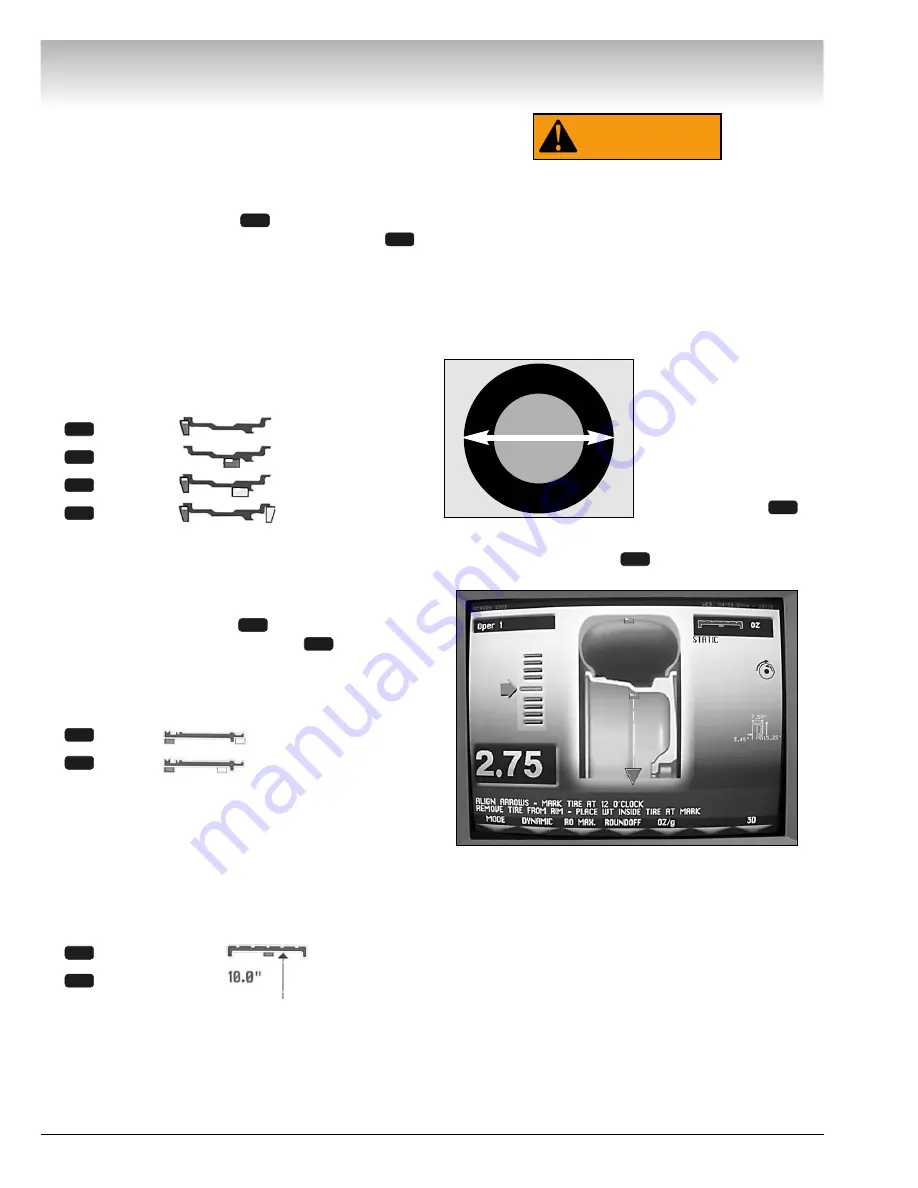
Static Modes
Choose a static balance for wheel assemblies that
are not possible to balance dynamically or for narrow
wheels. For example, a motorcycle wheel that has a
small wheel width.
Select the MODE option
for the modes menu
and then select the STATIC MODES option
.
Choose the option that best fits the available weight
locations.
a. For a “single weight”, choose any one plane loca-
tion.
b. For “two weights”, choose any two plane locations.
Using this approach can reduce the amount of induced
dynamic unbalance by splitting the correctional weight
value among two different planes.
- STATIC1
- STATIC2
- STATIC3
- STATIC4
Have the following items handy: an appropriate wheel
assembly mounted on the balancer and a selection of
weights.
Special Modes
Select the MODE option
for the modes menu.
Select the SPECIAL MODES option
to choose a
mode for the following special type wheel assemblies.
PAX Balance -
Select the appropriate option for the
PAX wheel that best fits the available weight locations.
- PAX1
- PAX2
Have the following items handy: a PAX wheel assem-
bly mounted on the balancer and a selection of Tape-A-
Weights™.
Patch Weight Balance -
Use a static patch weight bal-
ance when there is a very large unbalance in a tire
assembly or if a very large tire has a large unbalance. A
weighted balance pad (patch weight) is placed inside the
tire in the center to compensate for the large unbalance.
- PATCH (static)
- DIAMETER
↑
Have the following items handy: measuring tape and
various patch weight sizes.
Note:
Before proceeding with Patch Weight Balance,
it is recommended that you use the Optimization
(Match Balance) procedure first, see page 21, in order
to use the smallest patch weight.
The Patch Weight Balance involves the loos-
ening of tire beads and the inflation of a tire.
Training is necessary in tire changer opera-
tion and understanding the dangers
involved during bead seating and tire infla-
tion before attempting this stage of the
Patch Weight Balance procedure. Read the
operators manual supplied with the tire
changer and consult a supervisor.
The patch weight balance steps are as follows:
1.
Measure the out-
side tire diameter, see
figure 32, and enter this
diameter manually on
the patch menu screen,
DIAMETER option .
Figure 32 - Measure Outside Tire Diameter
2.
Select PATCH option
. The balancer automati-
cally sets itself for a STATIC balance.
Figure 33 - Patch Screen
3.
Move the offset arm tip to the inside of rim to set
tape-a-weight™ location. Wait for beep.
4.
Spin the wheel.
5.
Align the on-screen arrows. Next, mark the tire at
12 o’clock. Then remove the wheel assembly from the
machine.
6.
Disassemble the tire and rim. Place patch weight
in the tire at location marked on the tire. Reassemble
tire and rim matching the marks on the tire and rim.
7.
Complete by balancing the wheel assembly fol-
lowing normal procedures.
3
4
WARNING
4
3
2
1
7
1
4
3
2
1
6
1
18 •
Important: Always read and follow the on-screen operating instructions.
Video Balancer
Outside
Diameter
































